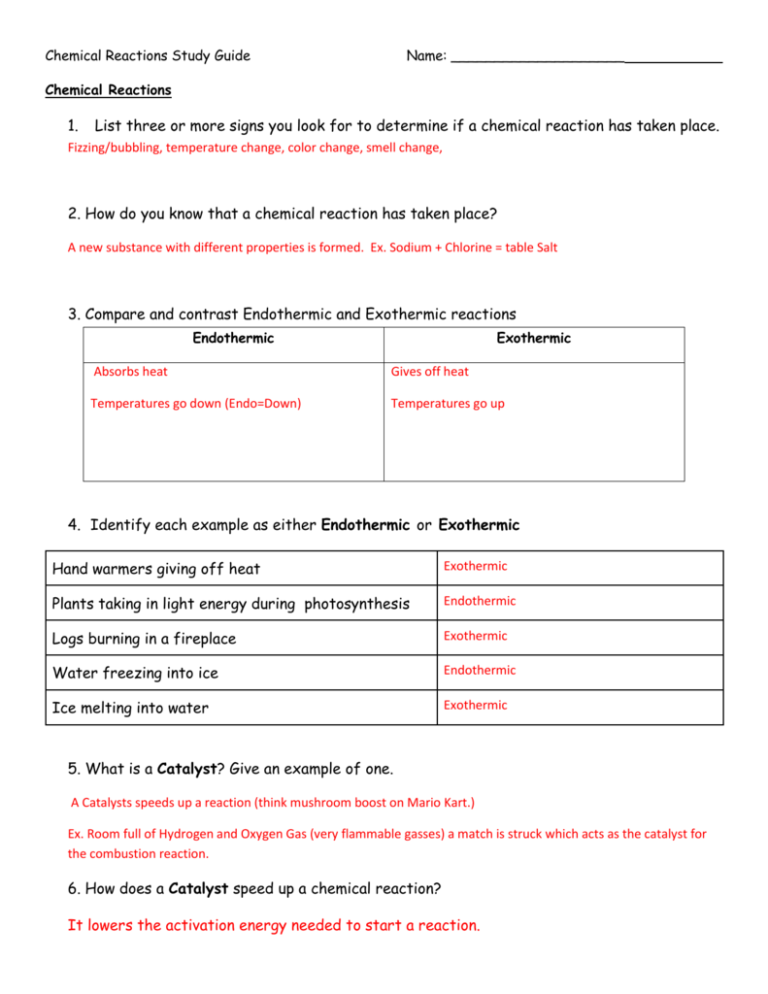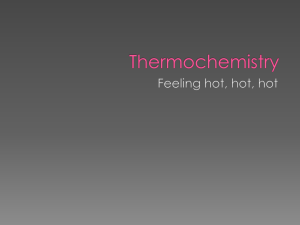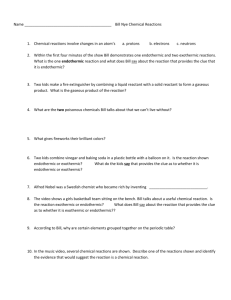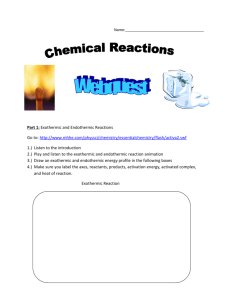Study Guide KEY
advertisement

Chemical Reactions Study Guide Name: ____________________ Chemical Reactions 1. List three or more signs you look for to determine if a chemical reaction has taken place. Fizzing/bubbling, temperature change, color change, smell change, 2. How do you know that a chemical reaction has taken place? A new substance with different properties is formed. Ex. Sodium + Chlorine = table Salt 3. Compare and contrast Endothermic and Exothermic reactions Endothermic Exothermic Absorbs heat Gives off heat Temperatures go down (Endo=Down) Temperatures go up 4. Identify each example as either Endothermic or Exothermic Hand warmers giving off heat Exothermic Plants taking in light energy during photosynthesis Endothermic Logs burning in a fireplace Exothermic Water freezing into ice Endothermic Ice melting into water Exothermic 5. What is a Catalyst? Give an example of one. A Catalysts speeds up a reaction (think mushroom boost on Mario Kart.) Ex. Room full of Hydrogen and Oxygen Gas (very flammable gasses) a match is struck which acts as the catalyst for the combustion reaction. 6. How does a Catalyst speed up a chemical reaction? It lowers the activation energy needed to start a reaction. Chemical Equations 7. Fill in the chart. Types of Reaction Combustion Synthesis Decomposition Definition When oxygen (O2) combines with another compound to form water and carbon dioxide. (*Boom ) Two or more substances react to form a new substance(s) One substance breaks down into two or more simpler substances Single Replacement One element replaces another element in a compound Double Replacement Elements from two different compounds switch places 8. Use lines to match the equations with the types of Chemical Reactions Single Replacement A + B AB Double replacement ABC AB + C Synthesis A + BC AC + B Decomposition AB + CD AC + BD Chemical Formulas 9. For the following equations, Box-in the Products and Circle the Reactants 2NaCl → 2Na + Cl2 C2H4O2 + NAHCO3 → NAC2H3O2 + H2O +CO2 CaCl2 + 2NaHCO3 → CaCO3 + H2O + CO2 10. How many atoms of each element are in the following chemical formulas? Example: 2H20 = Hydrogen= 4 Oxygen= 2 C6H12O6 2CH4 Carbon = 6, Hydrogen = 12, Oxygen = 6 Carbon= 2, Hydrogen = 8 MgBr2 Na2CO3 Magnesium = 1, Bromine = 2 Sodium = 2, Carbon = 1, Oxygen = 3 Mg(OH)2 C7H5(NO2)3 Magnesium = 1, Oxygen= 2, Hydrogen= 2 Carbon = 7, Hydrogen= 5, Nitrogen= 3, Oxygen= 6 11. Use ball and stick illustrations to draw the following molecules. Example: H2O = a.) Ammonia (NH3) b.) Baking Soda (NaHCO3) Nitrogen = 1 Carbon=1, Sodium = 1, Hydrogen = 3 Hydrogen= 1, Oxygen=3 12. Water’s chemical formula is H2O. The ratio of hydrogen atoms to oxygen atoms is __2_:_1__. 13. A Compound is 2 or more different elements that are chemically bonded. 14. Which molecule best represents a compound? a. Bromine Gas (Br2 ) b. Oxygen gas (O2) c. Carbon Dioxide (CO2) d. Aluminum (Al) Conservation of Matter 15. How does the following chemical equation demonstrate that matter is conserved? The total mass of the Reactants is equal the total mass of the Products. 16. Label the equations as balanced or Unbalanced. Chemical Reactions Balanced or Unbalanced? 1 2Na + MgF2 → 2NaF + Mg Balanced 2 H2 + O2 → 2H2O Unbalanced 3 Mg + Cl2 → 2MgCl Unbalanced 4 NaOH + 2HCl → NaCl + H2O Unbalanced 17. In the above table, which equation shows the total mass during a chemical reaction stays the same? _#1_______









